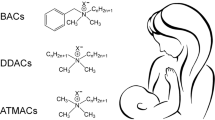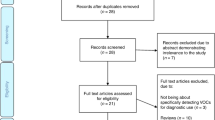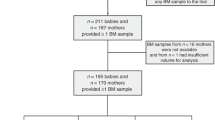Abstract
Objective
Estimate the migration of volatile organic compounds (VOCs) which have been identified by the EPA as a public health concern, from the enteral feeding system into human milk.
Study design
Unfortified human milk samples were infused through an enteral feeding system with varying duration of infusion, incubator temperature, and pre-infusion tube priming. Purge & Trap analysis and GC/MS were used to identify the VOC profile of milk pre- and post-infusion.
Result
Cyclohexanone and 3,3,5-trimethylcyclohexanone (3,3,5-TMC) accumulated significantly in milk samples post-infusion. Duration of infusion had a significant effect on VOC accumulation (p = 0.001). Accumulation patterns of cyclohexanone and 3,3,5-TMC differed significantly based on milk type (donor vs. mother’s own milk).
Conclusions
VOCs, migrate from plastic-based feeding equipment into human milk. Based on these findings, limiting the duration of feeding infusion would reduce VOC exposure derived from enteral feeding in the neonatal intensive care unit.
This is a preview of subscription content, access via your institution
Access options
Subscribe to this journal
Receive 12 print issues and online access
$259.00 per year
only $21.58 per issue
Buy this article
- Purchase on Springer Link
- Instant access to full article PDF
Prices may be subject to local taxes which are calculated during checkout



Similar content being viewed by others
References
United States Environmental Protection Agency. Volatile organic compounds’ impact on indoor air quality. EnviroAtlas. https://www.epa.gov/indoor-air-quality-iaq/volatile-organic-compounds-impact-indoor-air-quality. Accessed 13 Aug 2019.
Bazyar J, Pourvakhshoori N, Khankeh H, Farrokhi M, Delshad V, Rajabi E. A comprehensive evaluation of the association between ambient air pollution and adverse health outcomes of major organ systems: a systematic review with a worldwide approach. Environ Sci Pollut Res Int. 2019;26(May):12648–61.
Otto D, Molhave L, Rose G, Hudnell HK, House D. Neurobehavioral and sensory irritant effects of controlled exposure to a complex mixture of volatile organic compounds. Neurotoxicol Teratol. 1990;12(Nov-Dec):649–52.
Tsai WT. An overview of health hazards of volatile organic compounds regulated as indoor air pollutants. Rev Environ Health. 2019;34(Mar):81–9.
Ran J, Qiu H, Sun S, Yang A, Tian L. Are ambient volatile organic compounds environmental stressors for heart failure? Environ Pollut. 2018;242(Nov):1810–6.
Chang M, Park H, Ha M, Hong Y, Lim Y, Kim Y. et al. The effect of prenatal TVOC exposure on birth and infantile weight: the mothers and children’s environmental health study. Pediatr Res. 2017;82(Sep):423–8.
Perera F, Hemminki K, Jedrychowski W, Whyatt R, Campbell U, Hsu Y, et al. In utero DNA damage from environmental pollution is associated with somatic gene mutation in newborns. Cancer Epidemiol Biomark Prev. 2002;11(10 Pt 1):1134–7.
Faustman EM. Mechanisms underlying children’s susceptibility to environmental toxicants. Environ Health Perspect. 2000;108:13–21.
Rumchev K, Spickett J, Bulsara M, Phillips M, Stick S. Association of domestic exposure to volatile organic compounds with asthma in young children. Thorax. 2004;59(Sep):746–51.
Kim J, Kim E MS, Oh I, Jung K, Han Y, Cheong H, et al. Symptoms of atopic dermatitis are influenced by outdoor air pollution. J Allergy Clin Immunol. 2013;132(Aug):495–e1.
Prazad P, Cortes DR, Puppala BL, Donovan R, Kumar S, Gulati A. Airborne concentrations of volatile organic compounds in neonatal incubators. J Perinatol. 2008;28:534–40.
Eppler M, Donovan R, Schweig L, Cortes DR, Prazad P, Gulati A, et al. Effect of phototherapy on airborne concentrations of volatile organic compounds found in neonatal incubators. J Neonatal Perinat Med. 2012;5:221–7.
Ugarte UC, Prazad P, Puppala BL, Schweig L, Donovan R, Cortes DR, et al. Emission of volatile organic compounds from medical equipment inside neonatal incubators. J Perinatol. 2014;34:624–8.
Ulsaker GA, Korsnes RM. Communication. Determination of cyclohexanone in intravenous solutions stored in PVC bags by gas chromatography. Analyst. 1977;102:882.
Snell RP. Gas chromatographic determination of cyclohexanone leached from hemodialysis tubing. J AOAC Int. 1993;75:1127–32.
Snell RP. Capillary GC analysis of compounds leached into parenteral solutions packaged in plastic bags. J Chromatogr Sci. 1989;27:524–8.
U.S. EPA. Provisional peer-reviewed toxicity values for cyclohexanone. U.S. Environmental Protection Agency, Washington, DC, 2010.
Gupta P, Lawrence W, Turner J, Autian J. Toxicological aspects of cyclohexanone. Toxicol Appl Pharm. 1979;49:525–33.
Koeferl MT, Miller TR, Fisher JD, Martis L, Garvin PJ, Dorner JL. Influence of concentration and rate of intravenous administration on the toxicity of cyclohexanone in beagle dogs. Toxicol Appl Pharm. 1981;59:215–29.
Lim CH, Lee YH, Kim YS, Choi HS, Seo DS. Assessment of cyclohexanone toxicity in inhalation-exposed F344 rats and B6C3F1 mice: applications in occupational health. Inhal Toxicol. 2018;30:247–54.
Thompson-Torgerson CS, Champion HC, Santhanam L, Harris ZL, Shoukas AA. Cyclohexanone contamination from extracorporeal circuits impairs cardiovascular function. Am J Physiol Heart Circ Physiol. 2009;296:H1926–32.
Falk O, Jacobsson S. Determination of cyclohexanone in aqueous solutions stored in PVC bags by isotope dilution gas chromatography—mass spectrometry. J Pharm Biomed Anal. 1989;7:1217–20.
Danielson JW. Capillary gas chromatographic determination of cyclohexanone and 2-ethyl-1-hexanol leached from solution administration sets. J Assoc Anal Chem. 1991;74:476–8.
Everett AD, Buckley JP, Ellis G, et al. Association of neurodevelopmental outcomes with environmental exposure to cyclohexanone during neonatal congenital cardiac operations: a secondary analysis of a randomized clinical trial. JAMA Netw Open 2020;3(May):e204070.
El-Metawally D, Chain K, Stefanak MP, Alwis U, Blount BC, LaKind JS, et al. Urinary metabolites of volatile organic compounds of infants in the neonatal intensive care unit. Pediatr Res. 2018;83:1158–64.
Mills GA, Walker V. Urinary excretion of cyclohexanediol, a metabolite of the solvent cyclohexanone, by infants in a special care unit. Clin Chem. 1990;36:870–4.
Kim S, Halden R, Buckley T. Volatile organic compounds in human milk: methods and measurements. Environ Sci Technol. 2007;41:1662–7.
Lehmann GM, LaKind JS, Davis MH, Hines EP, Marchitti SA, Alcala C, et al. Environmental chemicals in breast milk and formula: exposure and risk assessment implications. Environ Health Perspect 2018;126(Sep):96001.
Blount BC, McElprang DO, Chambers DM, Waterhouse MG, Squibb KS, Lakind JS. Methodology for collecting, storing, and analyzing human milk for volatile organic compounds. J Environ Monit. 2010;12(Jun):1265–73.
Cortes DR, Basu I, Sweet CW, Brice KA, Hoff RM, Hites RA. Temporal trends in gas-phase concentrations of chlorinated pesticides measured at the shores of the great lakes. Environ Sci Technol. 1998;32:1920–7.
Bozzetti V, Tagliabue PE. Enteral nutrition for preterm infants: by bolus or continuous? An update. Pediatr Med Chir. 2017;39:159.
Occupational Safety and Health Administration (OSHA). Regulations (Standards—29 CFR): TABLE Z-1 limits for air contaminants. http://www.osha.gov/pls/oshaweb/owadisp.show_document?p_table=STANDARDS&p_id=9992. Accessed 2 Feb 2004.
Martis L, Tolhurst T, Koeferl MT, Miller TR, Darby TD. Disposition kinetics of cyclohexanone in beagle dogs. Toxicol Appl Pharm. 1980;55:545–53.
OECD/SIDS. Screening information data set (SIDS) of OECD high production volume chemicals programme. 1994.
CDC—NIOSH Pocket Guide to Chemical Hazards—Cyclohexanone. Centers for disease control and prevention. https://www.cdc.gov/niosh/npg/npgd0166.html (2018). Accessed 17 Jul 2019.
3,3,5-trimethylcyclohexan-1-one—Registration Dossier. ECHA. https://echa.europa.eu/registration-dossier/-/registered-dossier/5246/7/3/2 (2019). Accessed 17 Jul 2019.
Safety Data Sheet. Sigma-Aldrich. https://www.sigmaaldrich.com/MSDS/MSDS/DisplayMSDSPage.do?country=US&language=en&productNumber=T75752&brand=ALDRICH&PageToGoToURL=http%3A%2F%2Fwww.sigmaaldrich.com%2Fcatalog%2Fproduct%2Faldrich%2Ft75752%3Flang%3Den (2019). Accessed 15 Jul 2019.
Meier P, Patel A, Esquerra-Zwiers A. Donor human milk update: evidence, mechanisms, and priorities for research and practice. J Pediatr. 2017;180(Jan):15–21.
Peila C, Moro GE, Bertino E, Cavallarin L, Giribaldi M, Giulani F, et al. The effect of holder pasteurization on nutrients and biologically-active components in donor human milk: a review. Nutrients. 2016;8(Aug):477.
Silvestre D, Miranda M, Muriach M, Almansa I, Jareno E, Romero FJ. Antioxidant capacity of human milk: effect of thermal conditions for the pasteurization. Acta Paediatr. 2008;97:1070–4.
Acknowledgements
This research was supported by a grant from the Russell Institute for Research and Innovation. Thanks to Yi Li, MS for her guidance on statistical analysis and interpretation for this project and to Madeline Newman for assistance with background research for protocol development.
Author information
Authors and Affiliations
Corresponding author
Ethics declarations
Conflict of interest
The authors declare no competing interests.
Additional information
Publisher’s note Springer Nature remains neutral with regard to jurisdictional claims in published maps and institutional affiliations.
Rights and permissions
About this article
Cite this article
Prazad, P., Donovan, R., Won, B. et al. Migration of cyclohexanone and 3,3,5-trimethylcyclohexanone from a neonatal enteral feeding system into human milk. J Perinatol 41, 1074–1082 (2021). https://doi.org/10.1038/s41372-021-01036-3
Received:
Revised:
Accepted:
Published:
Issue Date:
DOI: https://doi.org/10.1038/s41372-021-01036-3
This article is cited by
-
Non-targeted analysis (NTA) and suspect screening analysis (SSA): a review of examining the chemical exposome
Journal of Exposure Science & Environmental Epidemiology (2023)



